Antique Hand-Painted Nippon Dish – Iridescent Shell Form, Rose Motif & Gilt Handle (Japan), c. 1915 🌸👑🇯🇵
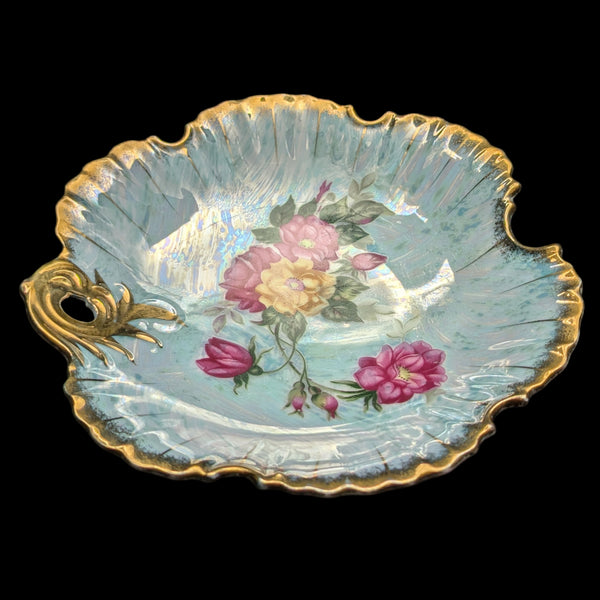
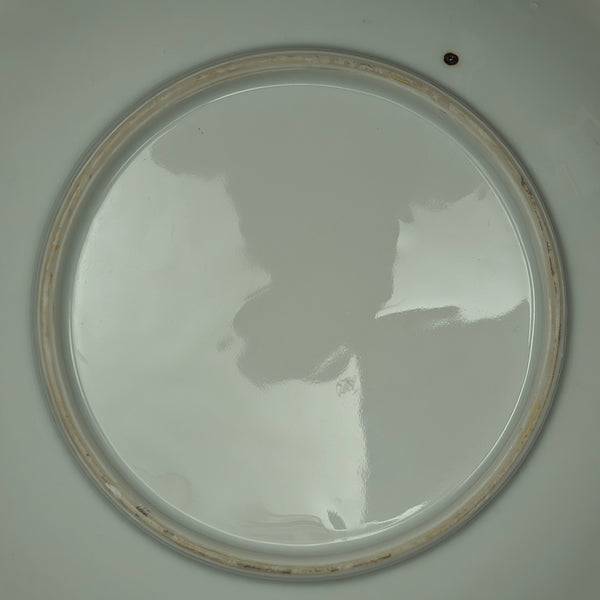
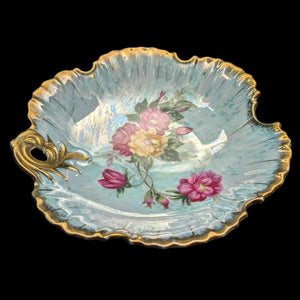
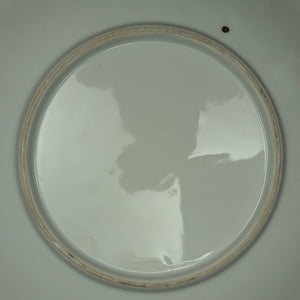
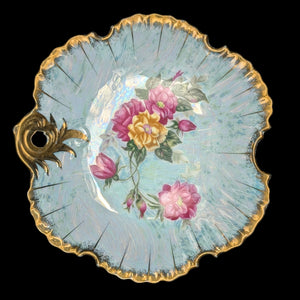
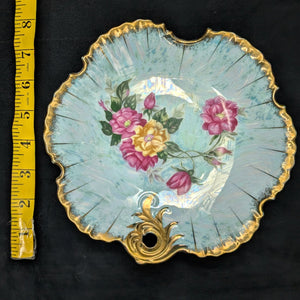
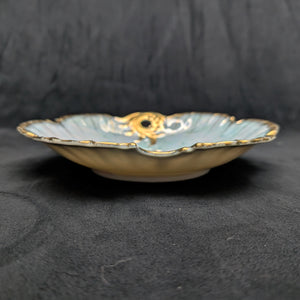
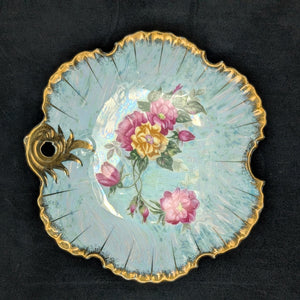
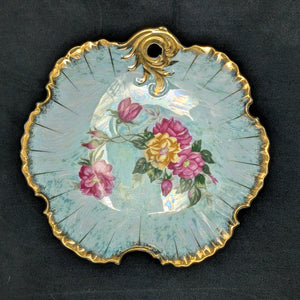
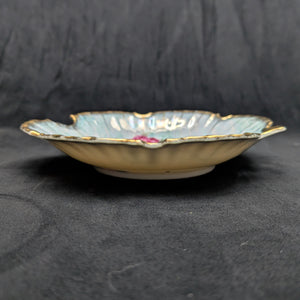
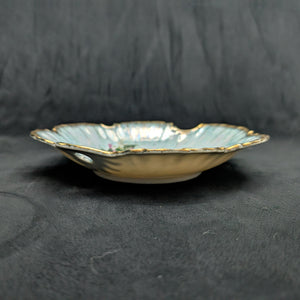
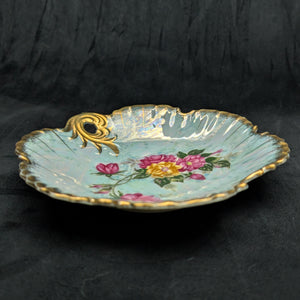
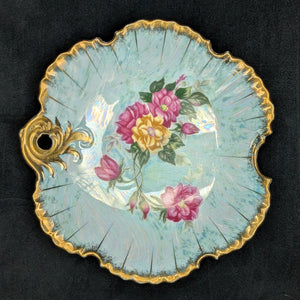
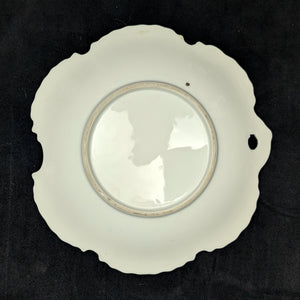
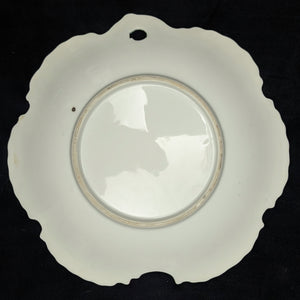
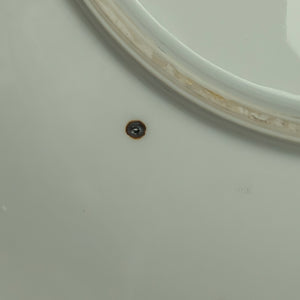
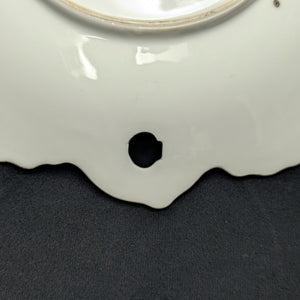
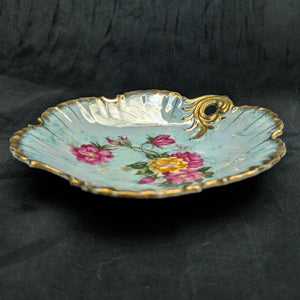
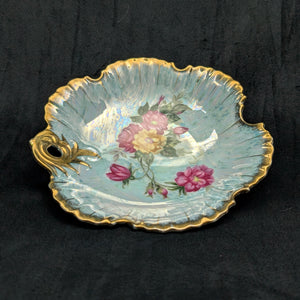
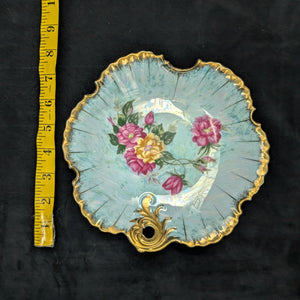
This is a RARE and elegant treasure, a beautifully made porcelain dish that exemplifies the decorative peak of Japanese export artistry. The piece is sculpted in a graceful, scalloped, leaf-like form with a single, heavily gilded handle.
The dish's surface features a stunning iridescent blue and white lustre glaze that provides a luminous canvas for the hand-painted pink and yellow roses. This artistry and elegant form establish it as a top-shelf acquisition for collectors of fine antique porcelain and period decorative art.
2. About the Decorative Dish 📖✍️✨
This decorative dish is a classic example of a "vide poche" (empty pocket) or small sweetmeat stand, designed for serving candies, nuts, or holding small dresser items. The form is a scalloped, asymmetric shape with a single ornate gold handle.
The defining visual element is the lustre glaze, which gives the surface a shimmering, opalescent blue-green effect. This is beautifully offset by the central hand-painted motif of vibrant pink and yellow roses. The heavy, sculpted gold work on the handle and rim completes the ornamental luxury of the piece.
3. About the Maker: The Nippon Export Era ✍️🏛️
This exquisite porcelain dish is an authentic product of the Nippon porcelain export era. While no manufacturer's mark is visible on the base, the style, quality of the porcelain, and the specific application of the iridescent lustre finish are hallmarks of Japanese workshops producing for the Western market between 1891 and 1921.
The craftsmanship is a clear demonstration of the artistry developed by major Japanese firms like the Morimura Brothers (predecessors of Noritake). These workshops were celebrated for their fusion of traditional Japanese artistry with European aesthetic demands, creating high-quality, heavily gilded porcelain like this dish.
4. Historical/Political Era Context 🌍🕰️📜
This dish was created during the late Meiji and Taishō periods in Japan, corresponding to the Edwardian and Art Nouveau eras in the West (c. 1900–1920). This was a golden age for Japanese porcelain exports under the "Nippon" designation.
The style reflects a cultural trend known as Japonisme in Europe, where collectors were fascinated by Japanese decorative motifs and techniques. The ornate, scalloped form and the iridescent lustre glaze were deliberate aesthetic choices to appeal to the period's love for ornamental art and vibrant colors. The piece is a tangible artifact of the intensive global trade that established Japan as a premier source of fine decorative ceramics.
5. The Ideal Collector 💡🧐🏛️
This RARE Nippon dish will appeal to a sophisticated collector with a specific interest in Asian export porcelain. The ideal buyer is a collector of Nippon or Noritake pieces, an enthusiast of Edwardian decorative arts, or a person who appreciates high-quality lustreware.
The dish's distinctive iridescent finish and elegant single-handle form ensure it is a visually desirable find. It is a strong asset for a collector curating a period-specific vanity display or a collection of small, ornate serving pieces.
6. Value & Rarity 💎✨🏛️
This dish is valuable for its age, its high-quality artistic application, and its excellent condition. The piece is authentically antique, approximately 105 to 125 years old.
Its market value is sustained by its ornate, sculptural shape (leaf/shell form with handle), the iridescent lustre glaze, and the meticulously executed hand-painted roses. The excellent, chip-free condition of the delicate scalloped rim and the gold work ensures it commands a premium value.
7. Condition 🔎📚✨
This antique porcelain dish is in excellent, well-preserved antique condition.
-
Structural Integrity: The dish is free of chips, cracks, or repairs.
-
Artistry: The hand-painted rose motifs are vibrant and intact.
-
Glaze: The iridescent lustre glaze is brilliant and shows no significant fading or loss of its shimmering effect.
-
Gilding: The sculpted gold handle and rim trim show minimal, age-appropriate wear.
8. Fun Facts & Unique Features 🤓📜🤩
-
Lustre Glaze: The iridescent finish is known as lustreware, achieved by applying a metallic oxide solution (often bismuth, gold, or silver) to the glaze before a final, low-temperature firing.
-
Nippon Era: Pieces made for export between 1891 and 1921 were legally required to be marked "Nippon", making this unmarked piece stylistically consistent with that period.
-
Hand-Painted Details: The artistry is a blend of transfer print (for the base color) and detailed hand-painting (for the flower highlights and petals).
-
The Single Handle: The leaf or shell form with a single handle was a very popular style for small dessert plates or "sweetmeat" dishes in the early 1900s.
9. Supporting Information 🏷️📦💰
-
Item Name: Handled Leaf/Shell Dish
-
Maker/Factory: Unknown Japanese Export Studio (Nippon Era Style)
-
Period: Antique (c. 1900–1920)
-
Medium/Material: Hand-Painted Porcelain, Iridescent Lustre Glaze, Gold Gilt
-
Decoration: Pink and Yellow Rose Motif, Scalloped Leaf/Shell Form
-
Origin: Japan (Export)
-
Approximate Dimensions: 7.5 inches (Estimated from visual scale using similar models)
-
Marking Transcription (Verbatim from Base): None (Unmarked)

